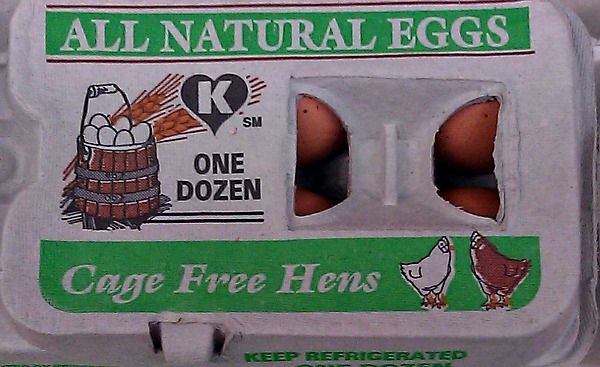 Meat and eggs labeled as “free range” or “cage free” have become increasingly popular in recent years as consumers try to source higher quality food for their families as well as to vote with their food dollars for humane and “green” conditions for the chickens themselves.
Meat and eggs labeled as “free range” or “cage free” have become increasingly popular in recent years as consumers try to source higher quality food for their families as well as to vote with their food dollars for humane and “green” conditions for the chickens themselves.
When most people think of free range, cage free chickens, they get a picture in their mind of happy chickens outdoors in the open air, completely free to express their chicken-ness by clucking around and pecking in the dirt for grubs and insects.
The truth of the matter is something else entirely. In fact, one of the more popular posts on the Healthy Home Economist Facebook page recently was a picture of the actual living conditions of free range, cage free chickens.
After seeing this Facebook post, Susan O. a reader who rescues “free range” chickens from commercial operations, sent me a series of shocking photos. Here are the photos along with her description of what these poor chickens endured, which turns out to be not much better than regular battery hens in cages.
Susan’s own words describing the 3 rescued “free range” hens – at only 1 year old:
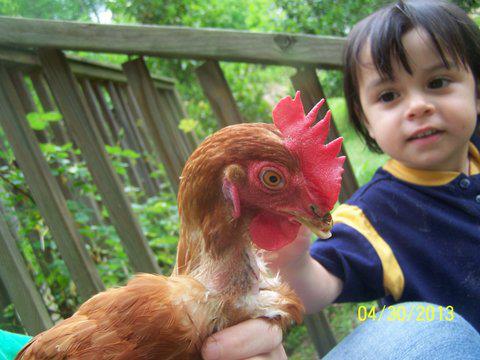
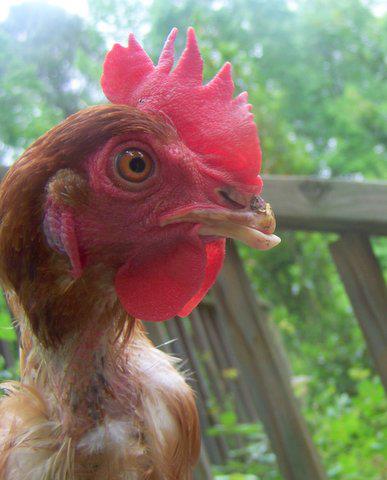
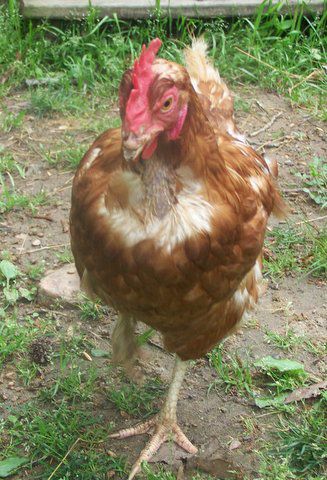
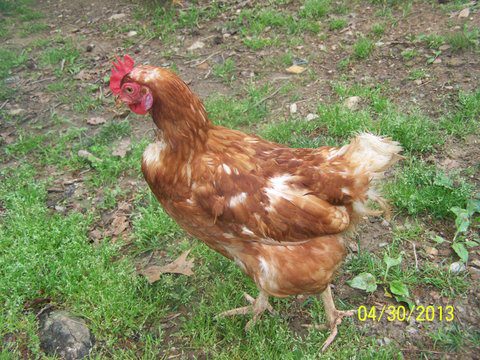
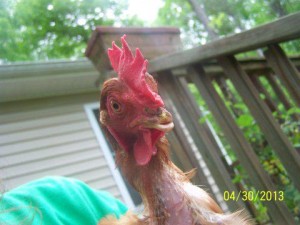
We “rescued” 3 hens from a commercial supplier who had one year old spent hens they wanted to sell. Their breed is Isa Brown.
The eggs were sold as “free-range” and “cage-free”.
We had no direct contact with the main supplier. It was very difficult to get the hens. Another person who purchases mass amounts of the hens from the egg supplier for $1.00 each was tracked down and he agreed to sell them to a group of rescuers for $10.00 each.
We’ve had these hens for a little over a month and they look much better then they used to. These photos were taken last week. When they arrived they were in much worse shape.
They’d never been outside, had no idea how to act like chickens. They wouldn’t roost at night, just pecked and walked around all night long.
I suspect their “house” was kept lit almost 24 hours a day for greater egg production. They pecked EVERYTHING. Trees, plastic, metal.
They were clueless. I had to cut their toenails. They were over an inch long!
One was limping her toenails were so long. They all had hen mites. All have feather loss. The combs on their heads were not the color they are now, but very pale, a sign of anemia and malnourishment.
The red fleshy part near the ear area was white and is still a little white today. Their eggs were without shells, had only a membrane on the outside from extreme calcium deficiency.
Another rescuer said her hen laid an egg and it broke inside her. They’ve also had their beaks cut. These hens will need to be on a special diet. They can’t crack corn or seeds with their beaks or pick up regular feed that’s not crumbled.
It’s like removing a human’s four front teeth and telling them to eat. They’ve learned to become very efficient at grabbing worms out of our compost bin. They are very gentle animals. We can pick all of them up and pet them.
People need to understand that the meat industry sees an animal as simply a product, to be used until they’re spent, then discarded like trash. The last thing the industry is worried about is our health and providing us with nutritious food.
We have a small homestead and do raise chickens and rabbits for meat, but these rescued ladies have a “free pass” to enjoy being chickens for as long as they live.
When friends shake their head and say “I couldn’t do it ” when I tell them about raising animals for meat, I draw the comparison between my healthy hens and these poor rescue hens.
If these “cage-free” hens were in this bad of shape at only one year old, I shiver to think how bad a typical battery hen would be. And no doubt, the gentleman gave us the better looking hens. Not everyone can afford pastured meat (but we manage, even on a budget 200% of the federal poverty guidelines and without taking any government assistance ), but pastured eggs can be afforded by most.
What Does a Healthy Chicken Actually Look Like?
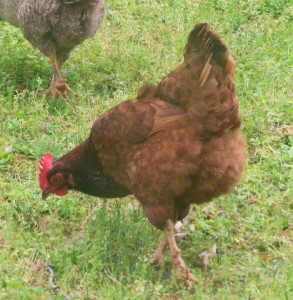 This is a photo of one of Susan’s long-time yard hens. She’s a comparable breed to the Isa Brown. She’s been truly free range since the day she was born.
This is a photo of one of Susan’s long-time yard hens. She’s a comparable breed to the Isa Brown. She’s been truly free range since the day she was born.
Note the tremendous difference between the two, “cage free” store label hen vs truly free range hen. No missing beak, feathers, white spots or mite infestation. The happy chicken is focused on the ground, pecking for insects and grubs instead of the pathetic, sad, vacant stare that signifies the horrifying animal abuse endured by chickens whose meat and eggs are labeled “free range” at the store.
In order not to be fooled into thinking your chicken and eggs come from happy birds like this one to the right when they actually come from beakless, anemic, mite ridden animals that have been so abused they can’t even peck in the dirt or crack corn, resolve to buy local!
When you buy from a neighbor or small scale local farmer who raises chickens, you can see them for yourself and note their health by the living conditions.
Abdicating responsibility for knowing exactly where your food comes from by trusting meaningless food labels in a store that proclaim eggs or meat as “free range” or “cage free” is not helping to secure quality food for your family nor is it helping to promote the cause of humane conditions for farm animals.
Sarah, The Healthy Home Economist








I’m torn between vegetarian chicken feed and non-vegetarian chicken feed. I don’t have chickens in my life yet but I’d like some people’s opinions the matter. I know chickens are not vegetarians but I’ve noticed that a lot of non-vegetarian chicken feed has animal by-product in it. Do you buy a specific brand that doesn’t have animal by-product? I’m torn because I neither want my future chickens to eat unhealthy vegetarian food but I also don’t want them to eat animal by-product as this is also not in their nature. Just looking for some opinions and clarification.
a chicken will eat any kind of meat it can, (including other chickens) naturally.
it depends what sort of chickens you are raising, how you would feed them. if you have fully grown, freely roaming hens, then I suggest you feed oyster shell and scratch grains along with your kitchen scraps. The meat in the scraps should make up for any short comings, along with insects the birds catch.
If you are raising meat birds, they must have complete feed. My suggestion would be an organic feed, the protein will probably be soy. You could also look for a feed that uses fish meal as the protein source, but it is going to be expensive. The birds should get plenty of grass and insects. You have to feed a growing animal enough protein to grow their frame.
If you are starting chicks that will become your future hens, feed them similar to the meat birds. They need good feed so that they can be effective layers later on. When they have finished growing, switch them to scratch and oyster shell.
My main concern would be getting the birds out on pasture.
While I agree with the premise of this article and am doing my best to raise hens for eggs for our family as healthily as I can, there are a few details in the article that possibly incorrectly put a negative slant on everything. One commenter mentioned one of the things, but no one seems to have noticed.
All hens after one year of age will go through a molt and replace all their feathers. At that point, they stop laying until they get all the new feathers in. That’s the point when the ‘industry’ gets rid of them because it doesn’t pay to feed them through it. Every hen varies in how they molt and what they look like through it. Some just blow a ton of feathers all at once and look a lot like the one that is pictured. But they generally recover more quickly and start laying again. Others just lose feathers a few at a time and can take 4 to 6 months to start laying again.
Also, while a hen is actively laying, she puts all her energy into egg production, so the shanks of her legs and her comb lose their color. That is one way to tell that they are laying. Since the hen pictured lost so many feathers and THEN started to get the color back in her comb, I would highly suspect she is molting and not currently laying any or very few eggs. That’s not because of any deplorable conditions she was raised in. Its totally part of the process.
Yes, she had her beak trimmed and no I don’t do that, but its an industry practice that keeps them from injuring each other. The term “hen-pecked” comes with good reason from years of domesticated chickens. There is always a hierarchy, and the top hen/s can get pretty nasty to the others. Yes, its worse in crowded conditions, but even free range/pastured birds in the best sense of the word, sometimes will pick on the bottom hen.
One last comment about the white behind the ear. Not sure exactly what was being referred to in the article, but ear lobe color on a hen determines the color of the egg they lay. It will never really change on an individual hen.
Sensationalism may create increased circulation, but in the end doesn’t help the issue. Please check all your facts when you read things like this.
Lisa,
These are my hens and I just wanted to take a second and reply to you.
The hens are not molting, they actually had hen mites. They do lay eggs. Our existing hens are free-range ladies and lay eggs daily and I’ve never seen a paleness in comb on any of them. In fact, as our pullets mature and are ready to lay, their comb darken into a deep red. The only time I’ve seen a pale comb was when we had a rooster injured by a dog, his beak was broken and he almost died of starvation before I figured it out. And the one time when we raised cornish cross for meat birds, and that’s another sad story.
My understanding is the cutting of the beak is to prevent them from injuring each other, like you said. However, we’ve not had one incidence of them pecking anyone since they’ve come here. Thankfully, I’ve yet to experience the hierarchy you speak of. Perhaps because my flock is smaller. we’re around 25-30 chickens now. In my opinion, the cutting is done specifically so they can pack as many hens into a building as possible. Not really presented in a negative slant, it’s just the way it is.
The color near the lobe did indeed change. These ladies are brown layers and this area was white.
They get better everyday and I was delighted to hear one of them cluck like a normal hen the other day!
While I do respect your point – and agree with a lot of it, I do also agree with Lisa.
While the molting on that particular hen may have been caused by mites it is NOT unusual for a hen to look like that while going through a molt. I’ve seen it many times on perfectly healthy hens.
And while you personally may have not seen your hens pecking each other and settling the pecking order I can guarantee you they did it – you just didn’t see it. They may have not been as aggressive about it as some hens, but it happens. Otherwise there would be no hierarchy. It begins happening when they are just little things.
My chickens have never looked that bad in a molt!
Horrifying! I am lucky to have just found a local source of pastured eggs (not to mention raw milk and cream, all at the same store!). They are pricey, but after reading this, so very worht it.
I think it’s great that you’ve shared this article. We all need to be reminded why it is important to patronize our farmer neighbors. I raise quite a few chickens and turkeys to sell and would like to add from my experience.
Pasture Raised- Joel Salatin type system (what I use). This can be for hens, turkeys, or meat birds. The birds are on pasture and moved very frequently to fresh grass. There is an enclosure of some sort, a fence or shelter. This is to provide predator protection! We love to eat chicken and so does every wild animal you can imagine (: The birds receive feed. This is to complement the grass that they are eating. You must have warm, pleasant weather to raise chickens this way– no winter chickens. The hens are moved inside for the winter and supplemented with hay, ground alfalfa (legume), or greens.
Free roaming- This is a backyard model. The birds have a house they nest in at night. They may wander anywhere they please during the day. This is a great way to keep a few birds for your family. However, predation is a big concern. Most farmers who sell eggs and meat must try to exclude predators to protect their flocks.
Free Range- Think of it as, “free to range”. There is a door on the hen house that goes outside. However it may lead to a dirt lot or the birds may not use the door. I use this term to describe my pastured birds because they are on range and it conjures a certain image in the mind that folks easily understand. However, corporations often exploit the term.
Cage free- Commercial term that applies to egg layers, meat birds have always been cage free. The chickens are loose in a building. They are not housed in battery cages. This doesn’t imply any access to grass, just that they are not in cages.
Everyone is correct, vegetarian chickens are a joke. Please tell your friends, many people are confused with this one.
I hope this helps. Most farmers, even the ones that run confinement operations, want to do right by their animals. It’s the economics of farming that drive some folks to put up huge buildings or feedlots and endenture themselves to corporations. Also, for the past 60 years, we’ve been fed the lie of cheap food. Many consumers only care about price. With the rising price of farm ground it is harder and harder to cash flow raising chickens or hogs outside. That is why it is soooo important to support local farmers who farm in a way that aligns with your values.
I think the point of the article is to buy local because when that box of eggs at the store say cage free (such as the supposed organic eggs at my store) doesn’t mean the chickens are out on green grass. Nor does it mean the chickens have been treated humanely … as the pictures are clear evidence. I can ALWAYS tell the difference in the eggs when I purchase even the most expensive ($5.00 a dozen) eggs at the grocery store. The yolks don’t even come close in color to my girls. Therefore I know for a fact those eggs do not come from chickens that are free to roam the yard that is covered in grass, weeds and other things.
The funny thing is growing up in the city our only choice was to purchase eggs at the grocery store. Yolks were pale yellow and had no taste at all, that was normal for me. After moving to the country 13 years ago I got my first chickens and opened their eggs they were so orange that I thought they were bad. LOL!
The terms “free run” and “free range” as I understand them, are not interchangeable. Free range is what pasteured chickens are, but doesn’t denote organic fed. While I whole heartedly agree with the entire premise of this article, I think your term usage is a bit confusing. I feel like you are trying to compare cage-free and free run chickens to free range and pasteured chickens. But the wording of your article makes it sound like free range and cage free are the same thing. Can you clarify?
There is no such label as “free run” and “free range” and “cage free” are the exact same thing except that 10 or so of the 10,000 chickens in the barn might have access to a tiny concrete porch once in a while if it says “free range”. The only label you should look for on a chicken is PASTURED, HERITAGE, and ANIMAL WELFARE APPROVED (not “certified humane” which does not require humane conditions).
This is just so sad and so cruel. Mostly all the “free range” and cage free eggs here in Vancouver, BC Canada claims that their chickens are vegeterian fed. I do avoid purchasing these eggs. Instead, I buy eggs from a local farmer that raises chickens. The eggs are from pasture raised chickens but they are also fed. They feed them whole grain layer pellets (ingredients list: whole grain wheat, peas, suncured alfalfa, canola meal, limestone, dicalcium phosphate, oyster shell, salt, canola oil, lysine, methionine, treonine, xylanases &/or phytase enzyme, biomos, yeasaac, vitamins a d e & b12, copper sulfate, zinc oxide, etc.) So my question is if these eggs are still good and healthy to eat? The whole grain layer pellets do contain canola oil and wheat so I was wondering if that will affect the eggs?
Anything the chickens eat will obviously affect the eggs. I would say chicken eggs on layer feed and pasture are still better than any store purchased eggs. Most people around where I live will feed layer pellets or scratch grains to their chickens. We personally do not feed our chickens anything unless it it garden or cooking scraps.
just by looking at the label. canola meal is listed in front of limestone (there won’t be over 10% limestone). the peas and alfalfa are providing most of the protein in the ration. there won’t be much canola in the mix. the canola oil is probably there to make the pellets stick together. if you’re pleased with the eggs otherwise, I wouldn’t change. however, you may make a gentle suggestion that you’d pay more for a non-canola diet. this may be the only feed available where you live. where I’m at, I have to drive 2 hours and spend twice as much for organic feed and most customers aren’t willing to spend the extra money for an organic bird. but, I always want to know what my customers are thinking and do my best to accommodate them.
What?! Of course not! Did you even read that ingredient list?!
We raise chickens for our own eggs. It is important to note when checking out your local farmers for healthy chickens that all chickens molt (lose their feathers in patches) at least once a year. Molting is not a sign of an unhealthy bird.
Chickens are generally pretty “trainable”. To the one who rescues, try putting the girls on their perch every night until they “get it”. It should only take about a week. They just might be able to return to their chicken ness.
Our chickens are a part of our family. I call them my “feathery babies”, and we have 21. Chickens are so easy to care for, too! I have a friend who lives on a city lot who keeps 4 chickens in her backyard! Research your local laws on chickens and see if you can keep your own… it’s well worth the effort, and you’ll know exactly what your eggs are made of 🙂